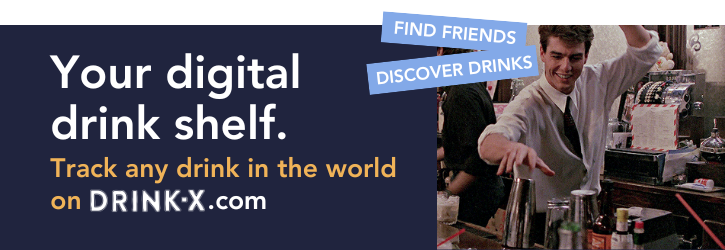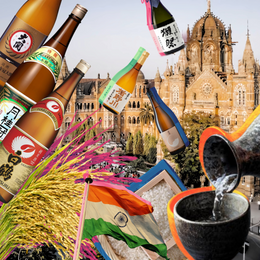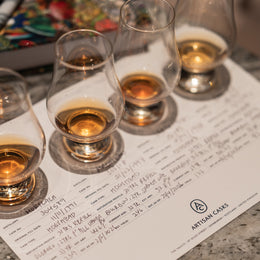Exploring Champagne's Historical Origins In Three Bubbles: Gosset Celebris, Dom Perignon & Dom Ruinart Blanc de Blancs

Champagne is probably, if not most certainly, the most visually distinctive of any wine – you know it when you see it; close your eyes and it’s instantly seamless to visualize it. It’s by now synonymous with celebrations and well, a good time. It’s basically liquid fun.
Yet, at the same time, its historical origins are about as far flung from mainstream awareness as it’s branding and emotional appeal.
So today, on behalf of two of Singapore’s foremost wine bars – Praelum and Convivial, the former a spiritual home for aspiring sommeliers, whilst the latter of which is a dedicated Champagne bar (not to mention the only from Asia on the Star Wine List) – we’ll be exploring the vinous history of Champagne. Praelum’s conducting the masterclass, whilst Convivial hosts a Champagne buffet of some staggering labels!


Two incredible bars tell the history of one of the world's most admired regions!
This is part one of a three-part series held by a collaboration between both bars that will take place over the course of several months, divided into three eras of Champagne history – Part 1: The Pioneers, Part 2: The Revolutionaries and Part 3: The Visionaries. And so for each edition, we’ll explore a different part of Champagne’s history in the form of a masterclass and also a Champagne buffet – both of which will feature a different selection of Champagnes that fit in with the part of Champagne’s history that we’ll be covering.

In Part 1: The Pioneers, we explore Champagne’s earliest and most iconic houses in three glasses of Champagne – the Gosset Celebris Extra Brut 2007, Dom Perignon Brut 2004 and Dom Ruinart Blanc de Blancs Extra Brut 2010. For this we have the every hilarious yet completely engaging Gerald Lu (who heads up Praelum Wine Bistro and is also the President of the Sommelier Association of Singapore) to walk us through.

Praelum's Gerald gets us acquainted!
With that said, let’s go!
First it’s instructive for us to get geographically oriented – the Champagne region (for which the sparkling wine is named after, and therefore only sparkling wine produced in accordance to appellation requirements within the Champagne region can be called “Champagne”) is located in the northeast of France, closer to the Belgian border. It’s rather near the capital city of Paris, and in terms of neighboring winemaking region, is closest to Burgundy. This is at least in part why Champagne, like Burgundy, focuses primarily on the Pinot Noir and Chardonnay grape varietals, and also utilising to its proximity to Paris, is what has allowed Champagne to gain quicker popularity with mainstream life.

Who, What, When, Where, Champagne
Within Champagne itself, there are numerous key sub-regions, yet historically it all starts in the city of Reims (pronounced Rahnse). Just outside the city of Reims lays several key crus (or classified vineyard areas) such as the Grand Crus of Mailly-Champagne, Verzenay, Verzy, Ambonnay, and Bouzy, as well as the Premier Cru sites of Ecueil and Sacy. Most of these Grand Cru and Premier Cru sites sit within the sloped ranges of Grande Montagne de Reims and Petite Montagne de Reims.
All in all, Champagne is home to 16,200 winegrowers, many of whom are small family-owned vineyards (typically about 2 hectares) who grow fruit that is then sold to larger Champagne houses (who themselves either don’t own any vineyards or own only a small percentage of the estate that satisfies their total fruit requirement). Thus it is common for most growers to mainly focus on growing the fruit (although some also produce the wines which are then sold to the larger houses), whilst houses are responsible for making the wines (as well as blending the cuvee if that is used by the Champagne house) and marketing the Champagnes. There are then 360 Champagne houses, 53% of them operate solely as Champagne houses (that do not grow the fruit themselves), whilst 47% of the are what is known as Grower Champagnes, where they handle every aspect from growing the fruit to producing the wines.

The ancient Roman chalk quarries, called crayeres, where Champagne houses today cellar their Champagnes.
Of all the Champagnes produced 38% of that is Pinot Noir, 31% is Chardonnay and 31% is Pinot Meunier (historically treated as more of a blending grape, yet more recently has gained prominence due to its use by artisanal Grower Champagnes). Since 2008, 40 more villages have been added to the roster of recognized Champagne producing areas, with growers having been able to start planting vines in these newly inaugurated villages since 2017.
Where economics are concerned, 80% of the revenue (that’s EUR 5.8 billion, with EUR 3.7 billion via export; Moet being the market leader making EUR 1.2 billion themselves) comes from the Champagne houses, stemming from the 326 million bottles sold, with about 1 billion more bottles held in reserve (kept by the Champagne houses for future release). The US, UK and Japan serve as the largest export markets, accounting for 27m, 22m and 12m bottles consumed annually respectively.

Who Started It All For Champagne?
The earliest origins of the Champagne region dates back to 57 BC, when the Celtic tribe, Remi, had begun allying with the Romans to fortify their surrounding regions. Their capital was then known as Gallia Belgica, or better known today as Reims. That said, at the time, the beverage of choice was nevertheless beer, even as still wines were made in the area as well. The Romans had in fact been the first to plant vines in the region, and the name Champagne would itself be taken from the Latin word "campania", a reference to the similarities between the rolling hills of Champagne and that of the Italian countryside of Campania, just south of Rome.
At its most formative, the region could be divided into Champagne pouilleuse, that is the chalky and barren plains east of Reims, and Champagne viticole, the forested hillside region between Reims and the Marne river, today known as Montagne de Reims, the latter of which held the region's earliest vines. Before Champagne was known for Champagne, it was known by rulers and armies for its strategic importance - the region occupied the crossroads of two critical trading routes, east-west between Paris and the Rhineland, and then also north-south between Flanders and Switzerland. Whosoever controlled Champagne, controlled trade, and whosoever controlled trade was King.

French Kings would make a habit of holding their coronation in Reims.
And so the Gallia Belgica capital would for many centuries prove to be a hotly contested battleground, constantly being under siege by an unenviable bunch - first the fearsome Atilla the Hun, followed by the Visigoths and then the Franks. And thus the region of Champagne would remain fluid in terms of the people and cultures it played home to. Reims would continue to itself be besieged 4 times and Epernay pillaged 4 times and burned to the ground twice as the fight for Champagne persisted. Yet perhaps most prominently, the French King Hugh Carpet would be crowned in 987 AD at the Reims Cathedral. A coronation banquet would be held where wine would be served, thereby setting once and for all the precedence for Champagne - and in particular the Reims Cathedral - to be a landmark where any King worth his weight in gold would be crowned. For 800 more years, every major monarch would be crowned in Reims, which of course lent great marketing affinity for any wine that came from the region or was popular in the region. Into the 1,200 and 1,300 AD, Champagne was to be the center of trade fairs, and the still wines (sparkling wines hadn't yet entrenched itself) of the region would catch on as far away as England, Spain and Italy.
Into the 1300's, England's King Edward III would wage a hundred year war against France, and lay claim to Reims, before eventually being driven out in the mid-1400's, when the French King Louis XI had taken back the seat, and of course was crowned in Reims. The region's still wines persisted in popularity, and would continue to ascend in status as the city of Reims itself continued on the upward, with the wines being served in court and of course to royalty.

Champagne Gosset's sloped vineyards just around Reims.
It was thus one Jean Gosset, Lord of Aÿ and Mareuil, who would on behalf of the Church watch over some 700 hectares of the best vines planted in the hills around Reims. When the Church fell in the 1500's and its land was being sold off to buyers, Gosset's grandson, Pierre Gosset, would quickly seize the opportunity and acquire much of the vineyards that his grandfather merely was allowed to manage, and would thereby establish a negociant business, where he sold his Pinot Noir wines. Where his Jean Gosset could only manage the vineyards, Pierre Gosset was now the owner of the vineyards, a momentous shift that would last 16 generations all the way until 1993. This makes Champagne Gosset the oldest wine house in the Champagne region, as it was established in 1584 in Aÿ, and notably isn't quite the oldest Champagne house a la sparkling wine, as Gosset had started off producing still red wines as was the popular style then, and only transitioned to sparkling wines later on.
And at this juncture, we'll get to taste our first Champagne - the Gosset Celebris Extra Brut 2007.
Champagne Review: Gosset Celebris Extra Brut 2007
The Celebris is the prestige cuvee of Champagne Gosset, the house of which was founded in 1584. This cuvee is only made in exceptional vintages, and is done so in the house style where there is no malolactic conversion (acidity of the wine is preserved as malic acid - think sourness of apples, which is not turned to lactic acid - more creamy and buttery) and with long ageing on the lees (the wine ages with the dead yeasts, which is used by Champagne-makers to give the wines more character). The cuvee is blind blended with no particular fixture on crus it draws its fruit from. It's 52-57% Chardonnay and 43-48% Pinot Noir. This has got 9-12 years on the lees, with 3-4.8 grams of dosage.
The Extra Brut style was created in 1995 (using the 1988 vintage as the base wine), and since then, only 8 vintages have been made ('88, '95, '98, '02, '04, '07, '08, '12).

Tasting Notes
Colour: Deep Gold
Aroma: It opens immediately doughy and of soft brie cheese rinds - that is to say, yeasty in a rustic manner - backed up immediately by savoury bruised apples waxed with honey. The savoury umaminess extends to scents of marmite and soy sauce, yet the bouquet remains clean and fresh, as well as concentrated. White and purple florals and fresh linens garnish the top note, contrasted against this firm and supple core, almost ethereal in its chewiness. With time it brightens yet remains resolutely firm, with now also beeswax and lacquered agarwood. It's quite the richness even on the nose.
Taste: Medium-bodied, rounded and rich, still really firm. It's doughy, accented by light honey and maltose, a touch lighter than its aromas, yet here also with brighter citrusy notes of lemon zest and grapefruit, wrapping around that core of doughiness. It's rustic and zesty, with bright and prominent, yet rounded acidity.
Finish: Light touches of balsamic here, weaved in with honey and maltose. That savoury umaminess of marmite emerges again. Still really doughy, with also tones of vanilla, and lingering zestiness of grapefruit and lemons. A seamless finish that's balanced and with great complexity.
My Thoughts
This was really interesting and one that immediately commands you to give it attention and thought. It takes a more oxidative stance with those savoury and umami notes of bruised apples and balsamic, that it then balances against the more typical zestiness of citrus fruits, with also a more prominent bit of doughiness. The acidity is present and also really rounded. It clearly demonstrates its complexity, and renders itself with much richness and firmness - incredibly textural - with more of a bias towards darker and more weighty tones. This feels like a foot in both camps of that of the distinctively defined Grand Marques (the Champagnes best known the world over) and also the more artisanal Grower Champagnes (the rising rockstars of the Champagne world).

Dom Pierre Perignon was not in fact a fan of the bubblies.
Benedictine Monk Pierre Perignon Raises The Champagne Flag (And Quality), Whilst The English Fall In Love With French Accidents And Made Sparkling
And so all through the 1500's and up till the early 1700's, the Champagne region was primarily known for producing still wines from Pinot Noir. Nevertheless, even as English demand for the region's wines remained booming, and barrels of the wine were constantly being shipped to England, the reality was that winegrowers in Champagne were simply unable to produce red wine with the same richness and colour as their southern Burgundian neighbours. This was largely chalked up to the Champagne region's climate, and so even as the English were largely happy with the pale pinkish-light red wine from Champagne, this was insufficient to win over the French when compared to Burgundy's reds. To the extent that Champagne's winegrowers would thus attempt to shift towards producing white wines from white grapes, which still remained light in flavour, it wasn't till the 1700's that it became well understood locally that the best wine Champagne could produce was a "white" wine from red grapes.
And thus in the 1600's, it was up to a French Benedictine monk by the name of Dom Pierre Perignon, who had made great strides in helping Champagne's winemakers figure out how to make quality wines. Perignon had joined the religious Benedictive Order when he was 17, and by the time he was 30, was transferred to the Abbey of Saint Pierre d'Hautvillers to be appointed as cellar master.

There, Perignon would be amongst the first to consistently blind taste test wines in order to determine a grape's quality - through this, he had concluded that he liked Pinot Noir most. He would begin pruning the Order's vines aggressively (an early idea for green harvesting to increase the fruit's concentration), set harvest time to the cool and damp early mornings (thereby preserving freshness), sorting the fruit to make sure they were not bruised or broken (standard practice today), and would start pressing and clarifying his wines, whilst reducing maceration (allowing for the wines to retain a light colour even as it was from red grapes). Whilst often credited for inventing sparkling wines (the process being called Methode Traditionelle or Methode Champenoise, wherein a sweet grape-based liqueur is added to the fermented-dry wine to start a second round of fermentation creating the fizziness), the reality was that Perignon was heavily consumed by how to prevent wines from turning fizzy, which was then thought to be a defect.
At the time, fermentation was poorly understood, and winemakers were constantly faced with bottles that would spontaneously go fizzy and explode - quite the catastrophe when unintended and worse yet, unexplained! What had in fact been happening was that wines were often bottled whilst they were still undergoing fermentation, and when the weather cooled (as is the case in the northern region of Champagne), fermentation would halt as the yeasts became inactive even as fermentable sugars had remained in the wine. And when spring came around and temperatures rose back up, these yeasts would re-activate and continue its fermentation, shoring up carbon dioxide in the thin French wine bottles that would exert great pressure causing an explosion. This rumbling in the cellars caused by the carbonation was even termed le vin du diable or "the Devil's wine", and winemakers then would believe that when the rumbling stopped was when the wine was safe and ready to enjoy. Perignon himself had been prompted to procure thicker wine bottles from England, which he figured might help mitigate the "problem".

This rather rudimentary (and accidental) process was in fact the earliest innings of sparkling wines, and in southwestern France then, had for some time already been understood as methode ancestrale, a deliberate act done by monks down south to create fizzy wines. In fact, the methode ancestrale isn't too far off from the more modern style of pet nat wines (petillant naturel), which come with an added ethos of organic farming and minimal intervention winemaking. Whilst France was still on primary fermentation (just one round of fermentation, that's either then bottled, or otherwise paused halfway through and restarted), over across the Channel in England, secondary fermentation was already being used, with the first recorded use of dosage (adding additional fermentable sugars to create a second round of fermentation) taking place in 1622. The English had already learnt of how they could spike sweet grape juice into barrels of wines or bottles in order to turn still wine sparkling - this was codified by English scientist Christopher Merret, and ironically was a reaction to the English's emerging love for the incidental sparkling wines coming out from France. What the French saw as defective, was beginning to take hold of the English crowd!
And with that we come to our second Champagne of the day - the Dom Perignon Brut 2004!
Champagne Review: Dom Perignon Brut 2004
Initially owned by Mercier, the house took its current form when in 1927 Paul Chandon-Moet married Francine Durand-Mercier, thereby inheriting Dom Perignon as dowry.
In 1936, Moet would thus release the 1921 vintage of its house Champagne and name it Dom Perignon, in homage to said Benedictine monk. This marks the start of the Dom Perignon brand, which has thus most recently celebrated going beyond its 100th anniversary. Fruit from a mixture of Grand and Premier Crus from Marne and Reims would be used, with a small percentage from Hautvillers (up to 5%), with the cuvee composed of 38-54% Chardonnay, 33-62% Pinot Noir and a rare use of Pinot Meunier - the 2004 Vintage saw 53% Pinot Noir and 47% Chardonnay. It's aged for 8 years at minimum on lees, with 5-7 grams of dosage.

Tasting Notes
Colour: Gold
Aroma: It's mega doughy and buttery - I've never experienced anything quite this buttery and doughy. It immediately strikes as a combination of melted butter, fresh dough and the crust of baked shio pan (Japanese salted bread rolls), or otherwise croissants. It's aromas are instantly and irrevocably compelling with just how texturally rich and distinct it is. It's so impressively well defined and immediately evocative. Nevertheless whilst the butteriness remains dominant, there are also more subtle scents of light honey, lemons and white florals beneath - it's difficult to compete with that intense butteriness. Remarkable!
Taste: Medium-bodied here, firm, although alittle more down to earth with its buttery and velvety, silky texture. The body is filled in with lemon zestiness, honey and maltose, with a gentle touch of doughiness. The acidity is evenly distributed and gentle. The bread-y notes are more toned down here, whilst the citruses take a step forward. Citrus pith, with then also a bit of savoury umaminess of marmite.
Finish: More zestiness ensues here, of lemons, wrapped around a core of dough and toasted brioche, all on a bed of honey and maltose. It's seamless through the finish, with all the aforementioned flavours coming together for a reunion. Light lingering zestiness, along with a touch of salinity and more of a savoury umaminess of bruised apples. The finish carries for a great length.
My Thoughts
It's aromas are bar none - I have never nosed anything quite like it. To put bluntly, it were as if I had stuck my nose into a bakery's kitchen wherein I had gotten too close to trays of melted butter on dough waiting to be baked, with another tray of now freshly baked croissants and brioche. The aromas are so incredibly distinctive and naturalistic, the textures of which are utterly compelling. It's dizzying this sort of aromatic intensity! The palate yet was more down to earth, incredibly velvety, with the buttery breadiness tempered down to allow the citruses to step forward into the light. The palate becomes less about gripping intensity (and perhaps shock value), and shifts the focus to more on balance. It combines zestiness, with rustic doughiness, honey, and also a more present umaminess. This all concentrates into the finish, pulling all the flavours of its palette into a sort of vortex that wounds all of them closest to one another as possible, and then sending it away on a beautiful slipstream of honey and maltose - seamless and of impressive length. This was such a gripping Champagne - it feels so intentional and deliberate, almost as if it were aiming to ace every criteria on which a Champagne was graded upon - and to that end, it does the job to a tee.

Ruinart has a long history of favouring the arts. Above: Commissioned artwork by legendary artist Alphonse Mucha for Ruinart.
Champagne Into The Mainstream
Whilst the spontaneously and randomly occurring fizzy wines from Champagne remained largely perceived to be a defect, the bubbly did find popularity with some in France - namely one Philippe II, the Duke of Orleans and Regent of France. Philippe II enjoyed the accidental sparkling wines very much and would often have it served at his nightly supper parties at the grandiose Palais-Royal in Paris. Word got out and this sparked a frenzy as these novelty sparkling wines, even if unintentional, had now become quite fashionable.
This potentially lucrative opportunity was not lost on Nicolas Ruinart, who had heard from clerical Benedictine uncle, Dom Thierry Ruinart, on just how popular these sparkling wines were becoming in Paris (Dom Ruinart having served at the Abbey of Saint Germain-des-Prés near Paris), and that the establishment of a Champagne house dedicated to the making of sparkling wines would be a phenomenal idea. Yet at the time, the Ruinart family had been in the textile business, and so Nicolas would find a way to weave in these beguiling bubblies. With the 1728 ruling by the new French King, Louis XV, that allowed for wines to be transported now in bottles instead of being limited to barrels, Nicolas Ruinart, would thus start offering bottles of sparkling wines as gifts to his family's textile clients.

As transport by barrels were poor at keeping in the fizziness, this meant that sparkling wines, no matter how popular or otherwise, was up till that point limited to the local vicinity. Yet with the new ruling allowing for wines to be transported in the form of bottles, this enabled the sparkling wines to consistently be delivered to Paris in good quantities. And so what started out as novelty gifts for the Ruinart family's customers would become so popular that within just a couple of years, Nicolas Ruinart would drop the textile business altogether to start in 1729 the first Champagne house dedicated to sparkling wines as we know them today. This was the start of the emergence of the Champagne houses we recognise today.

Ruinart today.
And Dom Ruinart was right - Champagne would achieve great and sustained popularity once the logistics were sorted out. Demand exploded and Ruinart would go on to acquire an old crayere, a Roman chalk quarry, the sort that Champagne houses boast of today as their incredibly lengthy tunnel cellars where thousands of bottles of Champagnes are aged within. By 1764, Ruinart became the first to ship out of France sparkling Rosé Champagne.
Champagne Review: Dom Ruinart Blanc de Blancs Extra Brut 2010
In 1966, Ruinart would undergo a pivotal shift when cellar master Bertrand Mure had decided to declare 1959 a prestige cuvee, yet uniquely it would be focused on the use of white Chardonnay grapes, and hence helping to popularise the "white from white" Champagne, or otherwise known as Blanc de Blancs (as opposed to "white from black" or Blanc de Noir, where the focus is on the use of black Pinot Noir grapes which are pressed with minimal grapeskin contact preventing the dark colour from the skins from colouring the wine).
The Dom Ruinart Blanc de Blancs is 100% Grand Cru Chardonnay from 4 villages, and is aged for 9 years on the lees at minimum, with 4-5.5 grams of dosage. This prestige cuvee is not produced every year.

Tasting Notes
Colour: Light Gold
Aroma: Fresh and bright, this is lighter and more elegant. It gives off a light yeastiness with a more firm doughy core that's glossed with an outer layer of honey and maltose, topped with white florals and a citrusy accent of orange and lemon peels. The zestiness is nevertheless gentle, with then also some minerality. With time, it develops more onto lemon meringue and vanilla cream, with a depth of stone cellar mustiness.
Taste: Medium-bodied here, it's bright, vibrant and lively, definitely more precise and forward, and also really distinct, with a zestiness of lemons and grapefruit backed by candied maltose and a touch of vanilla cream and doughiness. The body is firm and moderately substantial, neither heavy nor fully lifted. It possesses a subtle yet understated richness that's accented by brighter notes of citrus and rustic doughiness. The doughiness here feels less of fresh dough, and more of a more dried out dough that's been left out to rest for some time.
Finish: The zestiness carries through, lemons and grapefruits, backed by light notes of honey and dough, with dried and concentrated maltose. It's giving this aged quality through its mustiness, with also more on a mineral bit of oyster shell. The finish is firm and crisp, rich, with then lingering aromatics of honey and zest.
My Thoughts
This was a really clean and yet also concentrated Blanc de Blancs that is firm and well-defined, confidently conveying its complexity and nuances all rather boldly. It's really well-composed and feels like a long tapestry of twists and turns yet very much singular and cohesive - it feels like exploring the various facets of a sole identity. It has a really satisfying and sufficient heft to its body that gives it more of a presence that captures your attention. What I particularly liked here was these little easter eggs of sorts where it feels like the Champagne is very subtly indicating some sort of agedness. It's as if you focused alittle closer on what might have initially came across as a rather standard and inconspicuous flavour, and instead it gestured to you to follow it down a lesser known pathway that takes you to a different vantage point - by which I am referring to the dried doughiness on the palate and the dried maltose on the finish, both of which conveyed this mustiness, and a dried and concentrated quality, that gives it a dimension of age. A really engaging and captivating Blanc de Blancs that's entertaining and full of little surprises!

Left to Right: Gosset Celebris Extra Brut 2007, Dom Perignon Brut 2004, Dom Ruinart Blanc de Blancs Extra Brut 2010
To Be Continued...
And with that we come to the end of Part 1: The Pioneers from Convivial and Praelum's three-part collaboration exploring (and tasting) the history of one of the world's most storied and celebrated beverages - Champagne.
Be sure to stay tuned for Part 2: The Revolutionaries and Part 3: The Visionaries, which will be hosted by Convivial and Praelum into the second half of 2025. But why wait? Hit Convivial and Praelum up for great wines, food and company!

We're also left with several footnotes relevant to this formative part of Champagne history:
The Earliest Champagne Houses
- Ruinart (1729)
- Chanoine (1730)
- Fourneaux (1734)- now Taittinger
- Moet (1743)
- Vanderveken (1757) - now Abele
- Delamotte (1760) - now Delamotte and Lanson
- Dubois (1770) - now Roederer
- Heidsieck (1785)- now Piper, Charles, Heidsieck and Co
- Jacquesson (1798)
Key Developments In Champagne (1700's - 1800's)
1735 - Champagne applied ficelage (tying down Champagne corks)
1764 - Ruinart makes the first Rose
1806 - Remuage invented by Clicquot
1827 - First corking machine invented
1841 - The muselet (cage) was invented
1844 - Jacquesson patented the plaque (the metal cap)
1848 - Perrier Jouet made the first Brut Champagne
1864 - The Pupitre (rack) was invented
1865 - Every house was making Brut
1884 - a la glace was invented to remove sediment
1885 - Perrier Jouet sells 3x the price of Lafite in Christie's
1889 - Laurent Perrier invents San Sucre and zero dosage
Kanpai!

@111hotpot






